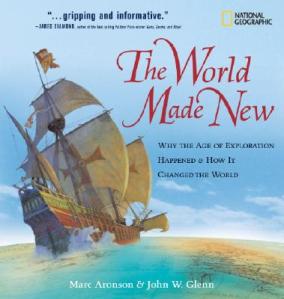 I always approach books about the age of exploration with a great deal of caution. Political correctness, the scourge of our age, often infects these books to such a degree as to make them useless. Yes, I know that the Europeans were not always kind and benevolent, but neither were they devils (at least only a few were). I know that the native Americans had a more developed culture than the Europeans gave them credit for, but they were not the noble savages of Rousseau’s fantasy.
I always approach books about the age of exploration with a great deal of caution. Political correctness, the scourge of our age, often infects these books to such a degree as to make them useless. Yes, I know that the Europeans were not always kind and benevolent, but neither were they devils (at least only a few were). I know that the native Americans had a more developed culture than the Europeans gave them credit for, but they were not the noble savages of Rousseau’s fantasy.
So, I was impressed as I was reading The World Made New, published late last year by The National Geographic Society. The World Made New manages to steer a fairly steady middle course and accurately report the virtues and faults of all the players in the dramatic encounter between the new world and the old world in the 1500s. Here’s a representative paragraph from the last page of the text:
“The Spaniards with their sailing ships, horse, muskets, and germs were no less foreign to the peoples of the Americas than space aliens would be to us. All the more remarkable, then, that the Aztec noblewoman Malinche quickly learned Spanish and could translate for Cortés. All the more astonishing that Africans ripped out of their homelands and dropped into the Americas invented ways to live and propser. All the more inspiring that men of conscience, such as the Spanish priest Bartoleme De Las Casas, devoted themselves to defending the Americans from other Spaniards.”
A central theme of the text is that the voyages of the 1500s affected the entire globe. The impact was not one-sided, nor confined to the new world. The final third of the book is entitled “A World Joined,” and it is the most valuable (and thought-provoking) part of the book. The authors explore the ways in which contact between cultures changed everyone. Diseases were exchanged (with disastrous consequences all over the world); Plants and animals were exported and transplanted; Populations emigrated, exploded, and collapsed; Diets changed; New World gold and silver flooded the old world economy – with dramatic economic effects. Again, a sentence from the text will illustrate its originality, thoughtfulness, and balance:
“In 1491 no one in North or South America had ever seen a horse, cow, or gun; not a single person living in Europe, Asia, or Africa had ever eaten a tomato, a potato, or an ear of corn.”
Anyone studying or teaching the 1500s, the Age of Exploration (which occurs simultaneously with the Protestant Reformation) would be well served by reading this book. The text is targeted for the upper elementary grades (probably 5th-8th), but high school students and adults will find the information arresting and thought-provoking.
The World Made New is a 64 page hardback, 10.4″ x 9.75″ with color illustrations and maps throughout. The price is $17.95 and it can be ordered directly from Greenleaf Press.
– Rob Shearer
Director, Schaeffer Study Center
Publisher, Greenleaf Press